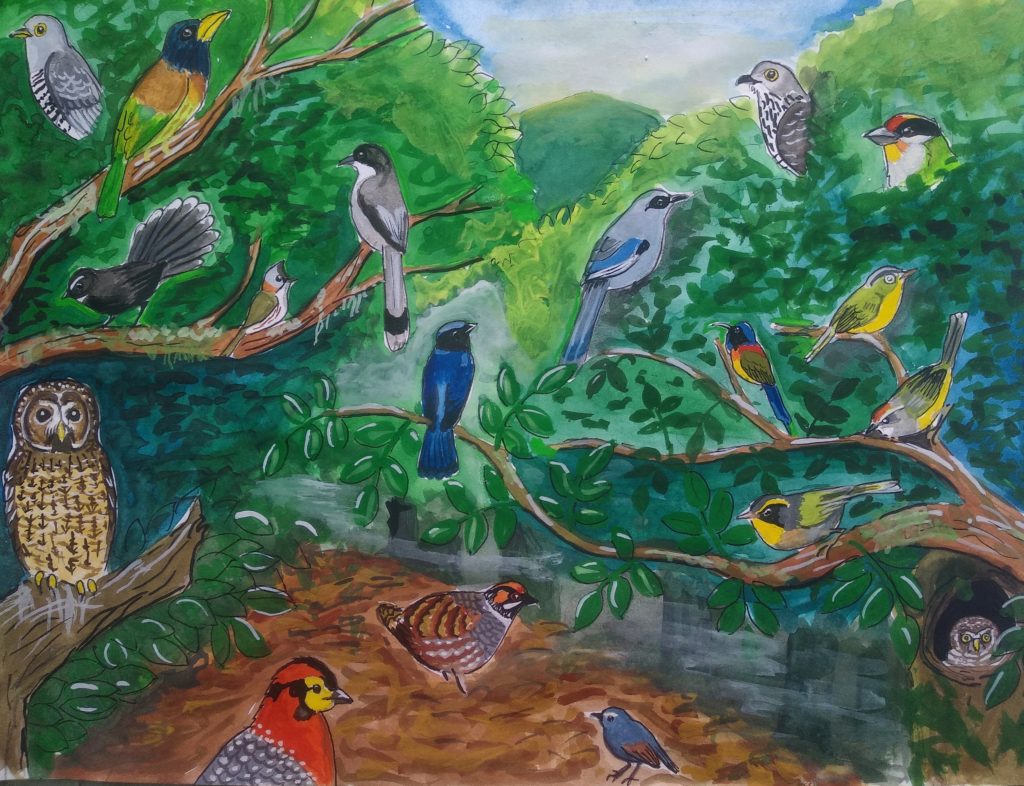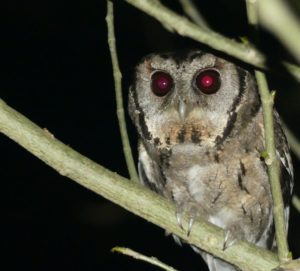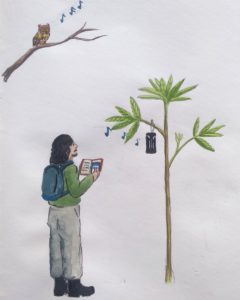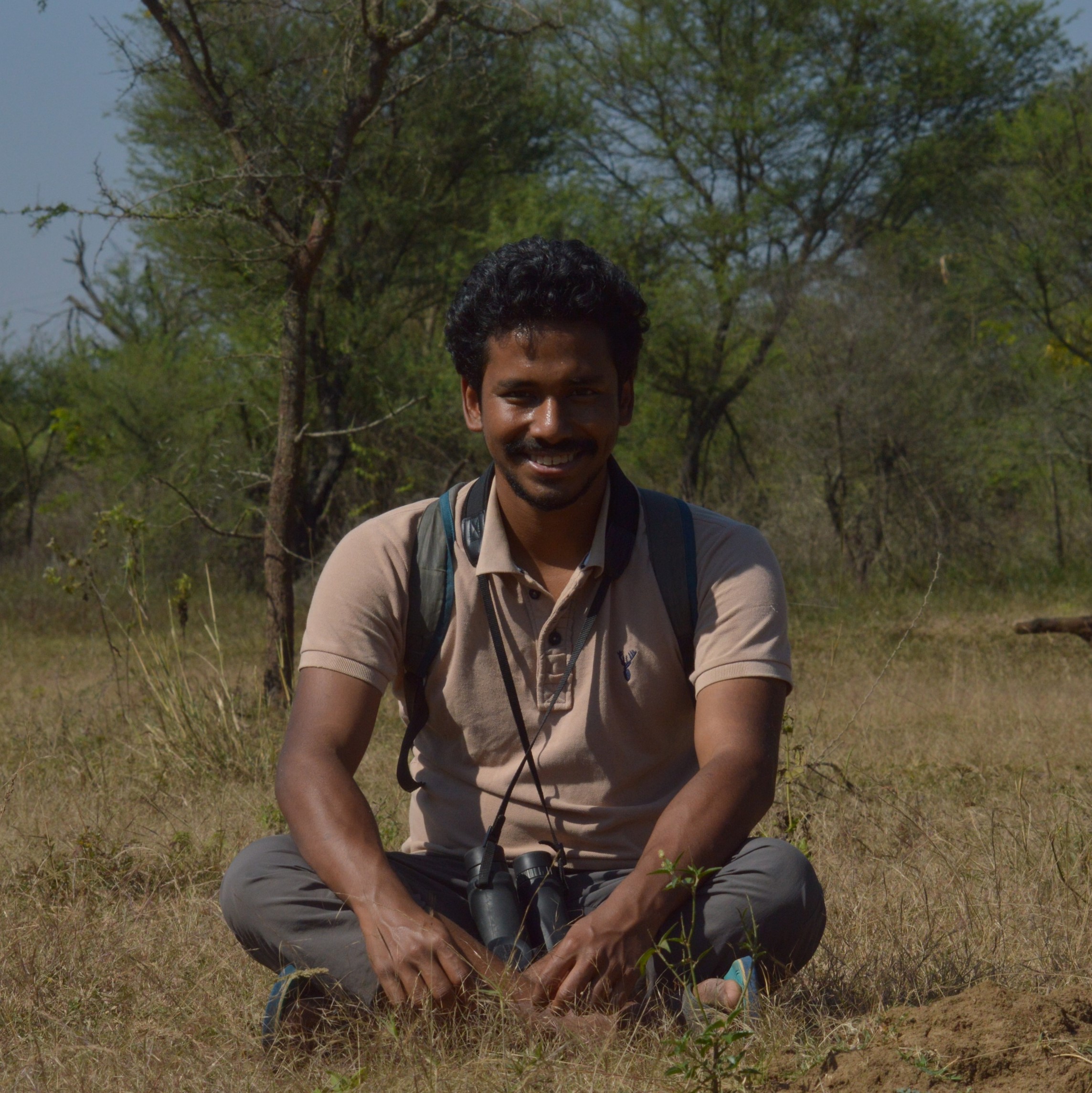Perhaps an experience of forest at night is something one can’t forget. More so, if you observe a night turn to dawn and the orchestra of birds to commence, reach climax and end as beautifully as it started. In my assignment to train a local team in bird monitoring, in remote Nagaland, I found myself acknowledging that choosing to work on birds was my best decision.
It was 3:30 am, I woke up to the chill as the fire had turned low. Lying in my sleeping bag, I could see the dark silhouette of the canopy through which a thousand stars were peeking. I sat up by the charcoal, which was red and glowing, to keep myself warm. Others were still fast asleep while the forest was waking up. In the dense mixed oak forest which was still very dark, the stars slowly disappeared and the first call of the dawn began, the Large Hawk Cuckoo. The vigil of the Himalayan Owl hadn’t ended then, nor was it over for the Blyth’s Tragopan, as they called before it turned bright. Soon the Himalayan Cuckoo made its presence known. Sky turned light grey by then and barbets were awake. The Great and Golden-throated Barbets announced the dawn uninterrupted from the top of canopies. I could see the shapes of the trees by then. From the ground that gently sloped down around 50 yards away, the long whistles of the Hill Partridges got louder. Then the lower storey of the forest woke up. The metallic calls of Large Niltava, White-throated Fantail, Lesser Shortwing and the Mountain Tailorbird filled in between the whistles of the partridges. The sky was blue by then; I saw the lush green of the forest but mist was still around. Warblers and sunbirds started chirping and the dawn chorus was reaching its climax. When the sun rays touched the top of a distant hill, the sibias, yuhinas and fulvettas also joined the chorus. Finally, I heard a distant call of the Collared Owlet. Slowly the sun grew, the mist disappeared and finally the dawn chorus ended.
 The components of dawn chorus in Thanamir, Nagaland; art by Kaushik Sarkar
The components of dawn chorus in Thanamir, Nagaland; art by Kaushik Sarkar
This is how my love for birds took shape..
As a kid growing up in a city, exposure to nature was limited to me except my annual summer vacation visit to my birth place, Chittaranjan, West Bengal. This yearly visit used to be the most exciting time for me. Chittaranjan being a railway colony with plenty of wild spaces and wooded gardens, it harboured many creatures: snakes, snails, insects, jackals and birds! My fascination for nature and wildlife began there, fueled further by all the documentaries I watched. Perhaps I had watched more documentaries than cartoons as a kid. The interest grew considerably and I continued to learn about wildlife from various sources. Newspapers became my regular source of new information, be it natural history articles or wildlife issues. I used to collect newspaper cutouts of animal photographs; names and details related to that image helped me recognize many species that occurred in the locality. Whenever in Bengal, I wanted to find snakes and observe them. The naïve me always wanted to handle them and perhaps tell others which ones aren’t venomous. But with family members not so happy with this particular interest, I shifted my attention to something which was diverse, relatively much easier to find, observe and most importantly, safer. Bird life in Chittaranjan was brilliant, and soon I realized it wasn’t bad in the cities as well. Now I had a taxon which I can find and observe anywhere. Much later when I got the freedom to explore in my undergrad days, my first-hand experience of wilderness in the Aravalli hills of Gurgaon made me strongly attached to birds and wild spaces.
My interest in questions related to ornithology generated from the natural history of different species. The most fascinating for me was regional differences in species composition. My first question was why are some species more common in some areas while rare or not found in others? Although my own research as a young student did help me explore some ideas and answer some of these questions, my true sense of research came during my master’s in Wildlife Biology and Conservation at National Centre for Biological Sciences (NCBS) in 2018. During the course I learnt to critically think and understand ecology. I met many people there who were equally interested in ornithology and I looked up to them to learn about birds. The course included readings of research papers, and when I found that there are many things we still don’t know much about, I wanted to study those. Birds were always my focus and most of my reading would be on birds. Over the duration of the course, with multiple field trips, assignments, literature reading and short projects, I was primed to work in the research field. My interest, readings and natural history knowledge allowed me to focus on ornithology questions in research. My Master’s dissertation was an opportunity for a hands-on deep dive in the research world and it allowed me to understand and execute a research project on birds.
I currently work as an ‘Executive-on ground projects’ at The Habitats Trust. I am currently working on designing a holistic conservation project for the Critically Endangered Bengal Florican in the Terai region of Uttar Pradesh. My work involves designing a study to find the most suitable breeding sites for grassland obligate Bengal Florican. It also involves protecting these sites and suggesting grassland management protocols that may help the species. It needs me to find where the floricans are, understand which sites they are choosing and why.? It also requires me to find and identify the threats and how we can address them. As a young ornithologist in the making, I find joy to watch and understand birds in their habitats. Opportunities like this allow me to contribute to the survival of the species we like.
I like what I do because..
I guess no joy is bigger than being in the field and watching birds do what they are doing in their habitat. Field work allows us to experience the wild to the utmost. It’s challenges and rewards make life more exciting. Although the purpose of field work remains collecting data for the science we do, in this process of data collection, we get to know much more about the natural history of the species we work on. Field work has taken me to many stunning places, which otherwise I would have never gone to. I got to experience the rainforests of Dehing Patkai at night for my master’s thesis on owls; I got to climb and explore the highest peak on Nagaland, Mount Saramati, for my assignment to train local people in bird monitoring. In addition to the joy of all the landscapes and birds we get to see and observe during fieldwork, any useful insight or finding from the research we do can be extremely rewarding.
 Collared Scops Owl, one of my study species during Master’s thesis in the rainforests of Dehing-Patkai
Collared Scops Owl, one of my study species during Master’s thesis in the rainforests of Dehing-Patkai
The challenges I faced..
Challenges can be very different for each person depending on where and what they work on. Some challenges can be very simple, with solutions as simple as a phone conversation about logistics. Others can be even life threatening, like working in an elephant country at night, or during the time of local unrest. My work on owls during my Masters posed a heavy set of challenges, starting from designing the study to executing it. For this nocturnal group of birds, I eventually had to use an invasive method like call playback. But thorough thinking and careful study design allowed me to collect the data that seemed impossible at a point. The results suggested Dehing Patkai, Assam, to be a site of very high owl abundance and species richness. During fieldwork there, I ran into many troubles including elephants, suspicious locals, poachers and even questions from the army. At these times, a calm thought process, solution finding, consultation and being honest, can save your life. My field collaborators helped me a lot during those times.
 A usual sampling session of owls during my Master’s thesis. Using systematic call playback to find and record owl numbers. Art by Kaushik Sarkar
A usual sampling session of owls during my Master’s thesis. Using systematic call playback to find and record owl numbers. Art by Kaushik Sarkar
My later work at Bird Count India in 2021, involved me training people for bird monitoring in Nagaland and Chhattisgarh. My challenges then were connecting with people and communicating effectively. At that point, immersing myself with the community, by almost being part of it, helped me find the connection. I learnt that simplifying things for everyone to learn and enjoy makes our work more useful.
My advice to young researchers is..
The best advice would be to keep learning from everyone who has worked in this field long enough or someone who understands nature. It can be your advisors, professors, birders and most importantly people who live in close contact with natural spaces. Find a good mentor to discuss and learn about things. In the process, also build your own insights by reading and going on field visits. Regular field visits or general birding over time can provide knowledge that may not be available in books and perhaps that is when we ask questions and develop ideas. Many of our questions arise from understanding the natural history of a species, hence, a grip on natural history can be very helpful. To upgrade the natural history knowledge into science, one should look for any opportunity to work with people who study birds. Every person has a different skill set to share. Someone may be able to teach you the different methods of bird surveys while someone else may teach you how to work with the data generated from that. Understanding data and analyzing it does form an important component of an ornithologist’s job. Only interpreting data correctly can allow us to get interesting insights about the natural world. All these small components help us to be an ornithologist and once this is achieved, we just have to keep improving.
What one should avoid is to hold on to a certain idea. Many times we come with beliefs about a system or a species, there can be solid reasons for that. But one should always allow the ideas to go under the process of scrutiny. As with many birders or people who are involved in ornithology, expert opinion becomes the holy grail. As young researchers we can learn to believe everything they say and most of the time they are correct. But there can be times when there might be dissonance in reality and expert opinion so one must also make our own effort first. With time, we may also learn quite a bit such that people reach out to us for our opinions. At all times we must stay humble to our understanding of the larger world and we should not take offense when proven wrong but rather take it as a learning and move ahead. It doesn’t matter how long we stay in this field, in ornithology, there is always something new to learn.
Kaushik Sarkar
[email protected]
Executive-On Ground Projects, The Habitats Trust
Instagram:@kaushiksarkars88


This is amazing Kaushik! Keep shining! 🤗